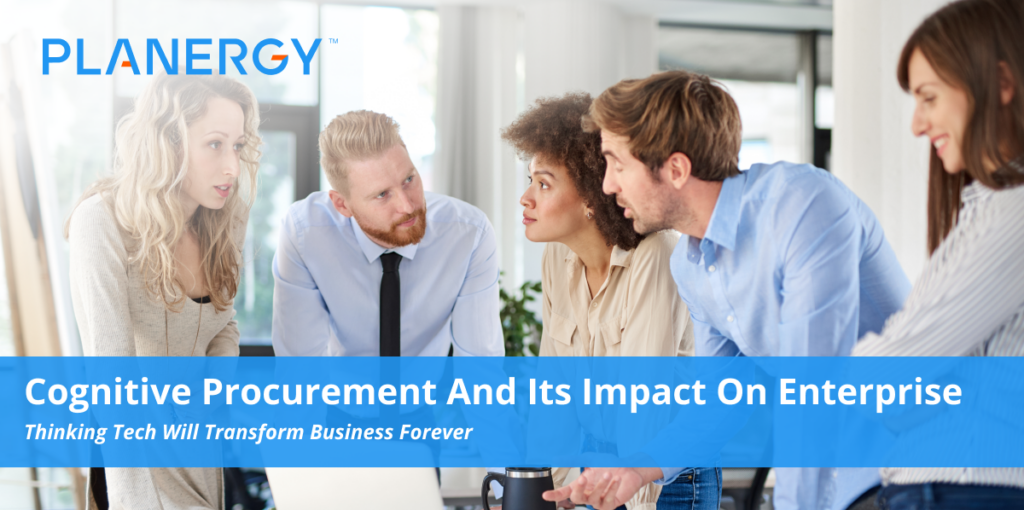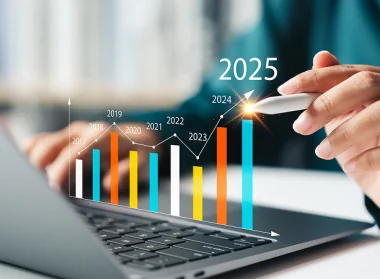In a world where disruptive technologies and big data are swiftly redefining how we do business, procurement professionals have a unique opportunity to solidify the procurement function’s role as a source of value, efficiency, and innovation for their organizations.
Digital transformation brings with it a host of new tools, including artificial intelligence (AI), deep machine learning, and predictive analytics we refer to collectively as cognitive technologies.
These “thinking” techs power a new paradigm known (unsurprisingly) as cognitive procurement.
But how, exactly, will cognitive systems like self-learning software bots and tools like data mining lead the chief procurement officers (CPOs) of today to a promised land of more strategic sourcing, better decision making, and value creation?
The answer lies in understanding what cognitive procurement actually is, the potential changes it brings, and how you can leverage its power to optimize your workflows.
Cognitive Procurement: An Overview
The promise of artificial intelligence lies in its potential to support, replace, or even supersede human intelligence in the tasks we give it.
In a data-heavy industry such as procurement, self-learning technologies can potentially handle both advanced tasks (analyzing massive amounts of information to produce contextual insights in real time) and a bevy of time-consuming, repetitive tasks (invoice matching, data entry, approval routings) with alacrity and accuracy humans can only dream about matching.
Like its predecessors, cognitive procurement is also fundamentally transactional. Unlike its predecessors, however, it is also defined by technological tools that have sensory, reactive, and contextually strategic capabilities. AI excels at data-driven tasks, and over time, it can teach itself to get even better.
By bringing more intelligent tools to the table, along with transparent and complete data that’s easy to access, analyze, and use in real time, ensures every transaction can be faster, smoother, and more cost-effective.
Better still, transaction data can be used in turn to achieve strategic sourcing, better forecasts and reporting, and make important decisions about opportunities to expand and innovate.
Achieving fully cognitive procurement requires a thorough knowledge of cognitive automation (also called intelligent automation).
Bringing together the versatility and customizability of process automation with advanced analytics and machine learning, cognitive automation powers cognitive procurement by bringing together people, processes, and data to create a shared data environment where some of the “thinking” is handed off to software.
This works especially well in procurement, since many of the low-level tasks suitable for contextual analysis and reaction by artificial intelligence are driven by facts, rather than gut instinct or complex considerations that require human understanding.
In fact, because they can combine input from human-friendly tech such as natural language processing (NLP) with the power, speed, and scalability of cognitive computing, cognitive systems can identify, analyze, and suggest alternatives that may not be immediately apparent to humans in the same time frame.
A few of the tools in the cognitive procurement kit include:
- Blockchain, for data security and improved network integrations (especially important in making the same internal and external data sources available to all applications).
- Cognitive Automation (Artificial Intelligence coupled with Data Centralization and Process Automation). Three unique but interrelated technologies make it possible to collect, store, organize, and analyze all of the data related to all of your procurement processes, from spend to supplier relationship management. Together, they allow for the creation of:
- Smooth, optimized workflows of all kinds (including purchase order creation, invoice processing, and approval workflows),
- Intelligent buyer-facing systems that automatically incorporate the correct vendor and contract data for swift and optimal purchasing, while eliminating rogue spend and blocking invoice fraud.
- Advanced supply chain analytics and vendor integration tools, bringing all your suppliers into the fold to make even more data, and subsequent improvements, available.
- Enhanced contract management. Automatic data population from the vendor database, in addition to pre-approved legal phrases and templates, allows for much faster contract creation and implementation. Integration with the blockchain allows for independent verification of transactions, automatic and secure “signatures,” and improved strategic and negotiation positions for buyers thanks to full transparency of vendor performance and compliance data.
- Data Mining, taking advantage of all that big data flowing into your servers from interior and exterior sources to reveal actionable insights, contextual suggestions for real-time decision-making, and long-term strategic sourcing and planning. Having access to current market data as well as historical transactional and vendor data, for example, could reveal important changes that need to be made in marketing or product development. It could also identify sources of serious risk, allowing teams to nip minor problems in the bud before they balloon into crises.
- The Internet of Things (IoT). Connecting the real world with the virtual realm, the IoT is used for creating digital prototypes (known as digital twins), monitoring real-world activities (such as the status of a shipping container or the quantities of items in inventory and duplicating their presence on virtual shelves for ordering, inventory, etc.), and even for creating virtual reality storefronts for buyers or service and support portals for vendors and consumers.
- Virtual Assistants/Chatbots. In addition to the software robots used to automate your procurement processes, cognitive procurement may also integrate more advanced self-learning “bots” designed to interface with vendors, buyers, and consumers. By connecting to a shared datasphere, these chatbots can use historical and current data to provide contextual answers, make suggestions for courses of action, or even accept new orders, changes, or returns.
Ultimately, it’s the procurement teams who embrace effective and comprehensive data management, a culture of digital transformation, and strong support for cognitive procurement from their staff, vendors, and customers who will reap its benefits in the future.
How Cognitive Procurement Will Impact Enterprise
While no two businesses will leverage the potential of cognitive procurement in quite the same way, it’s likely the tech tools at hand will be used by businesses of all kinds to achieve certain goals, including:
Greater Value and Lower Costs
Sitting at the heart of your company’s financial health, procurement has a special role to play. Any opportunity to reduce waste and improve efficiency and profits will have a widespread positive effect throughout your organization.
Complete, accurate, and transparent transaction data is already used today for deep analysis to determine strategic sourcing, contract management, and process optimization for spend.
It can also help procurement teams pinpoint potential roadblocks in their workflows, reducing cycle times and improving cost savings by increasing captured discounts and eliminating late payments.
In fact, a 2017 paper by research firm McKinsey & Co. found that automating the source-to-pay process can reduce overall spend by as much as 3.5%.
Tomorrow’s CPOs, however, will look beyond source-to-pay optimization for value creation.
Using next-gen data analysis and AI, they’ll combine procurement data with a variety of sources, both internal and external, to quickly and accurately identify the ideal suppliers for a variety of different projects around the globe, and then automatically generate contracts that can be reviewed, modified, and approved via blockchain.
The resulting competitive advantages, combined with the reduced risk and stronger supplier relationships that accompany mutually beneficial deals, will be a powerful source of goodwill, value, and growth.
Bridging the Virtual and Physical Worlds
Today’s procurement teams may take advantage of tools such as GPS and geotags to monitor the progress every order, either manually or using software robots programmed to generate alerts in case of delay, damage, or disaster.
The Internet of Things will bring even more data into play, providing real-time status updates on every single item, from position to location to temperature and physical integrity.
This data might even be used to create a virtual reality environment where staff can “step into” the shipment and examine its contents in real time, whether it’s in the shop or across the planet.
The capture and analysis of this data will reduce miscommunication, fraud, and insurance issues—and provide invaluable data for additional process refinements to slash waste and boost savings.
More Effective Risk Assessment
With the capability to process not just hundreds, but millions or even billions of data sets in mere moments, AI can distill insights from massive blocks of data and help you put them to use faster and more effectively than ever before.
Current AI tech allows you to monitor and reduce risk by tracking internal processes (spend, process and policy compliance) as well as external data like vendor performance and compliance history.
But future iterations will likely gain access to an ever-growing set of data for concurrent analysis, improving risk management exponentially.
Drawing on social media, news networks, market data, and other sources, tomorrow’s cognitive procurement solutions will be able to factor in variables such as the weather, domestic or international conflict, and the availability of production materials and skilled staff to chart out strategic decisions for spend, operations, marketing, and more.
These same sources can help with supplier relationship management, as well.
Ethical and socially responsible sourcing will most likely become even more important as time marches on, so being able to identify and connect with suppliers who meet your standards (and those of your customers) will be crucial to building an effective, value-focused supply chain.
Potential Obstacles to Effective Cognitive Procurement
The excitement surrounding cognitive technologies is palpable. But like all disruptive forces, their ultimate form may not be what we expect—especially if we don’t prepare the groundwork for their success with today’s decisions.
To be truly successful, cognitive procurement requires three important attendant systems:
- A unified datasphere, with adequate IT infrastructure and support.
- Corporate understanding of, and support for, analysis-centric decision-making.
- Full staff, management, and supplier support for cognitive technologies.
Without the first, the efficacy and completeness of your analysis will always be incomplete. Analysis and decisions made with incomplete data may put your bottom line and competitive performance in jeopardy.
Without the second, you’ll likely be caught in a culture war between the old guard and the strategic suggestions made by the AI.
Without the third, you may encounter resistance to change from both inside and outside procurement, particularly if you’re handing off buyer- and vendor-facing experiences to AI chatbots and self-service portals.
In the end, the best way to ensure your procurement organization is ready for tomorrow’s cognitive procurement is to invest in automation, analysis, and AI tools today.
- Begin building C-suite support for cognitive procurement, if you haven’t already.
- Work with your procurement solution provider to educate and train your whole organization as you design and then implement process automation, continuous improvement, and analysis-assisted strategic sourcing.
- Take the digital leap. Automate as many processes as possible, centralize your data sources, and work to create a unified datasphere where all applications can communicate and share data. Choose a cloud-based solution with leveled access to facilitate communication and communication while minimizing confusion.
- Document and then demonstrate for stakeholders the value created by implementing AI, automation, and analytics. Look to the future and be ready to incorporate emerging technologies as they enter the market for even greater value and savings.
Get Ready for the Future of Procurement
From hands-free purchase order systems to mining data sets with predictive analytics, cognitive procurement has the potential to forever transform the way procurement professionals pursue their trade.
Ultimately, it’s the procurement teams who embrace effective and comprehensive data management, a culture of digital transformation, and strong support for cognitive procurement from their staff, vendors, and customers who will reap its benefits in the future.
Will your company be among them?




